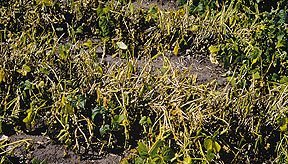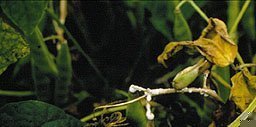White Mould (Sclerotinia)
If white mould is severe, bean yields may be reduced by 225-550 kg/ha (200-500 lbs./ac.)
Host Crops
Dry beans, field peas, canola, sunflowers, lentils, mustard, potatoes.
Biology
The fungus overwinters as hard black bodies or sclerotia in crop debris and in the soil. The disease cycle begins with the germination of the sclerotia to produce small, mushroom-like structures. Warm (15-25 degrees C or 60-75 degrees F), wet weather, 1-2 weeks before flowering, coupled with a thick bean canopy, favour this development.

Once these mushrooms have matured, each of them can release up to 2 million spores over a 5-10 day period. These spores germinate and infect bean plants, aided by a dead food source (usually the bean blossoms). The disease develops most rapidly at temperatures of 20-25 degrees C (68-77 degrees F). The fungus can spread from the dead blossoms to adjacent flowers, stems, leaves, and pods within 2-3 days. The sclerotia formed may persist in the harvested pods and seed, fall to the soil, or remain in the crop residue.

Symptoms Of Damage
The disease affects the stems, leaves, pods, and seeds of beans. The first symptoms are brown, water-soaked lesions that enlarge rapidly under cool, moist conditions. These lesions become watery, rotted sections of plant tissue. The lesions rapidly increase in size. Under humid conditions, such lesions may become covered with white, cottony growth. Within a week, black sclerotia are formed in the infected tissue. The lesions eventually become dry, bleached, and shredded. Wilt and subsequent death of entire branches and main stems may result when the fungus girdles the stem.
Scouting Techniques
If the field has a previous history of sclerotinia and the weather has been wet for two weeks prior to flowering, check for small mushrooms just before and during the early blossom stage. Look for soft, watery lesions that become covered with dense, white, cottony growth.
Economic Thresholds
White mould can affect both the yield and quality of the seed. The affected seed may be discoloured and lighter in weight than healthy seed. White mould also leads to increased levels of sclerotia in the soil. Affected fields may have to be taken out of bean production for several years.
Control Tips
- Plant varieties that do not produce a heavy vine. Provide adequate aeration between rows and within rows by decreasing the seeding rate or increasing the plant spacing.
- Dry beans should not be planted more than once every 4 years. Avoid rotations with other crops that are highly susceptible to white mould, such as sunflower and canola.
- A fungicide application is warranted if a dry bean field has a yield potential of 2250 kg/ha (2000 lbs./ac.) or more, white mould is a common problem in the area, and weather has been wet for 1-2 weeks before flowering. The fungicide treatment must provide good coverage of the entire plant, particularly the blossoms. Fungicides are much more effective in preventing white mould infection than they are at slowing disease development.
- Do not over-irrigate. After the pods have started to form, allow the soil surface to dry out before re-irrigating. Excessive applications of nitrogen should be avoided because they favour heavy vine growth.
For further information, contact your GO representative.

